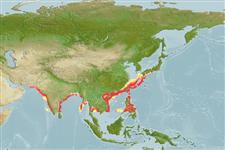Environment: milieu / climate zone / depth range / distribution range
Ecología
marino demersal. Subtropical; 38°N - 10°N, 62°E - 138°E (Ref. 114953)
Distribución
Países | Áreas FAO | Ecosistemas | Ocurrencias, apariciones | Point map | Introducciones | Faunafri
Indo–West Pacific; Pakistan to East China Sea (Shanghai), including Taiwan and possibly Japan and Philippines.
Conservation status maybe of concern in Northwest Pacific because of its inshore benthic habitat, low abudance, and the presence of intensive demersal fisheries (Ref. 47737).
Tamaño / Peso / Age
Maturity: Lm ? range ? - ? cm
Max length : 35.0 cm TL macho / no sexado; (Ref. 114953); common length : 30.0 cm TL macho / no sexado; (Ref. 114953)
Preorbital length about equal to preoral length (and much greater than prenasal length), and dark brown spots that are usually greater than eye diameter over a brown background (Ref. 49866).
Found in continental waters, both inshore and offshore (Ref. 9912). Biology little known (Ref. 9912). Maturity size of males at ca. 24 cm TL, birth size at ca. 11 cm TL (Ref. 114953).
Life cycle and mating behavior
Maturities | Reproducción | Spawnings | Egg(s) | Fecundities | Larva
de Carvalho, M.R. and J.E. Randall, 2003. Numbfishes from the Arabian Sea and surrounding gulfs, with the description of a new species from Oman (Chondrichthyes: Torpediniformes: Narcinidae). Ichthyol. Res. 50(1):59-66. (Ref. 49866)
IUCN Red List Status (Ref. 130435)
Human uses
Herramientas
Special reports
Download XML
Fuentes de Internet
Estimates based on models
Preferred temperature (Ref.
123201): 22.8 - 28.6, mean 27.1 °C (based on 1300 cells).
Phylogenetic diversity index (Ref.
82804): PD
50 = 0.5000 [Uniqueness, from 0.5 = low to 2.0 = high].
Bayesian length-weight: a=0.01175 (0.00476 - 0.02897), b=2.88 (2.66 - 3.10), in cm total length, based on LWR estimates for this (Sub)family-body shape (Ref.
93245).
Nivel trófico (Ref.
69278): 3.1 ±0.3 se; based on size and trophs of closest relatives
Resiliencia (Ref.
120179): Bajo, población duplicada en un tiempo mínimo de 4.5-14 años (Assuming fecundity<100).
Fishing Vulnerability (Ref.
59153): Low vulnerability (25 of 100).
